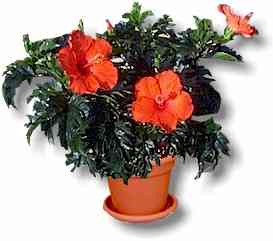What’s the difference?
Springtime is just around the corner and for some of you it’s driving right up your street, so get ready!!!!
Our main focus in these plant tips, is caring, growing and maintaining your plants indoors. Hey it’s springtime and it’s time to go outside and get some fresh air.
We are going to start off with a springtime favorite – Hibiscus. We basically find two styles of Hibiscus grown. The Hibiscus for outdoor/patio use and the "Florist Grade" Hibiscus. They are really different plants and there is a price difference.
What does it take to produce these plants and what makes them different regular Hibiscus.

History
Hibiscus have been cultivated for centuries. They were first grown in the Orient, later in Europe, and then in the United States. Hibiscus is an ancient Greek and Latin name. The most commonly grown species, Hibiscus rosa-sinensis means "Chinese rose". They are native to the tropical region of Asia, and tend to grow in wet or swampy areas. This explains why they want a steady supply of moisture and are not fond of drying out.
Hibiscus provide a wide range of colors and flower styles, reds, yellows, pinks, orange, white, peach and blends of colors. There are also single and double flowers. Most of the plants produced today are the species rosa-sinensis.
Charcarteristcis Of The Florist-Grade Hibiscus
Florist-grade biscus are shorter, denser and more compact then the patio style. They have more flowers, more branches and dark green leaves. Speaking of flowers. A florist-grade hibiscus looks more like a chrysanthemum.
The facilities to produce florist-grade are also much different. Most are produced in greenhouses, grown on benches, and use drip irrigation.
Propagation
Propagation starts in late summer and continues until mid-February. This schedule allows growers to have product available right after Christmas. Most of the plants sell from mid-March until the first week of June and finishes off in late October. Just in time for Poinsettias. The 6" pot is the most popular but 10" pots and 10" hanging baskets are available.
It is possible to propagate from seed, cuttings, air-layers or grafting and many growers maintain their own stock plants. For florist-grade plants, cuttings are taken from the stock plants and are placed under mist for rooting. Depending on the variety and the time of year, cuttings root in 20-60 days.
After cuttings have rooted they are hardened off on holding benches. Plants are pinched and young plants begin to take shape. Pinching is important as it will determine the density of the plant and also the bud count.
Once a plant has reached the desired height, growth regulators are applied. Growth regulators do two main things. Shorten the growth between the leaf nodes, and reduce the nitrogen that goes into the plant.
Some growers remove the flowers before shipping. As the flowers open they release ethylene, and the ethylene can in turn force young buds to drop.
Best Light for Flowering
For best flowering, hibiscus should receive as much light as possible. Most plants are grown in 3,000 to 5,000 foot candles.
Aphids can occasionally attack new growth, look at some of the insecticidal soaps as an option to control them.
While visiting your garden center keep this in mind. Hibiscus are heavy drinkers and aggressive feeders. Look for plants that are full, and have deep green color (this is for the florist-grade). They will probably need a good drink when they get home. The soil is usually made up of 60% Canadian peat moss, drains well and has good aeration. The flowers last for one day and you’ll need to remove the old blooms.
Plants that are losing their bottom leaves can be a sign that the plants are not being watered well enough or the plants were in transit too long.
There is a difference between florist-grade and the outdoor/patio styles of hibiscus. They both have their place in bringing the tropics to you. Next time you’re in the garden center check out the difference between the two styles.



{ 0 comments… add one now }
You must log in to post a comment.